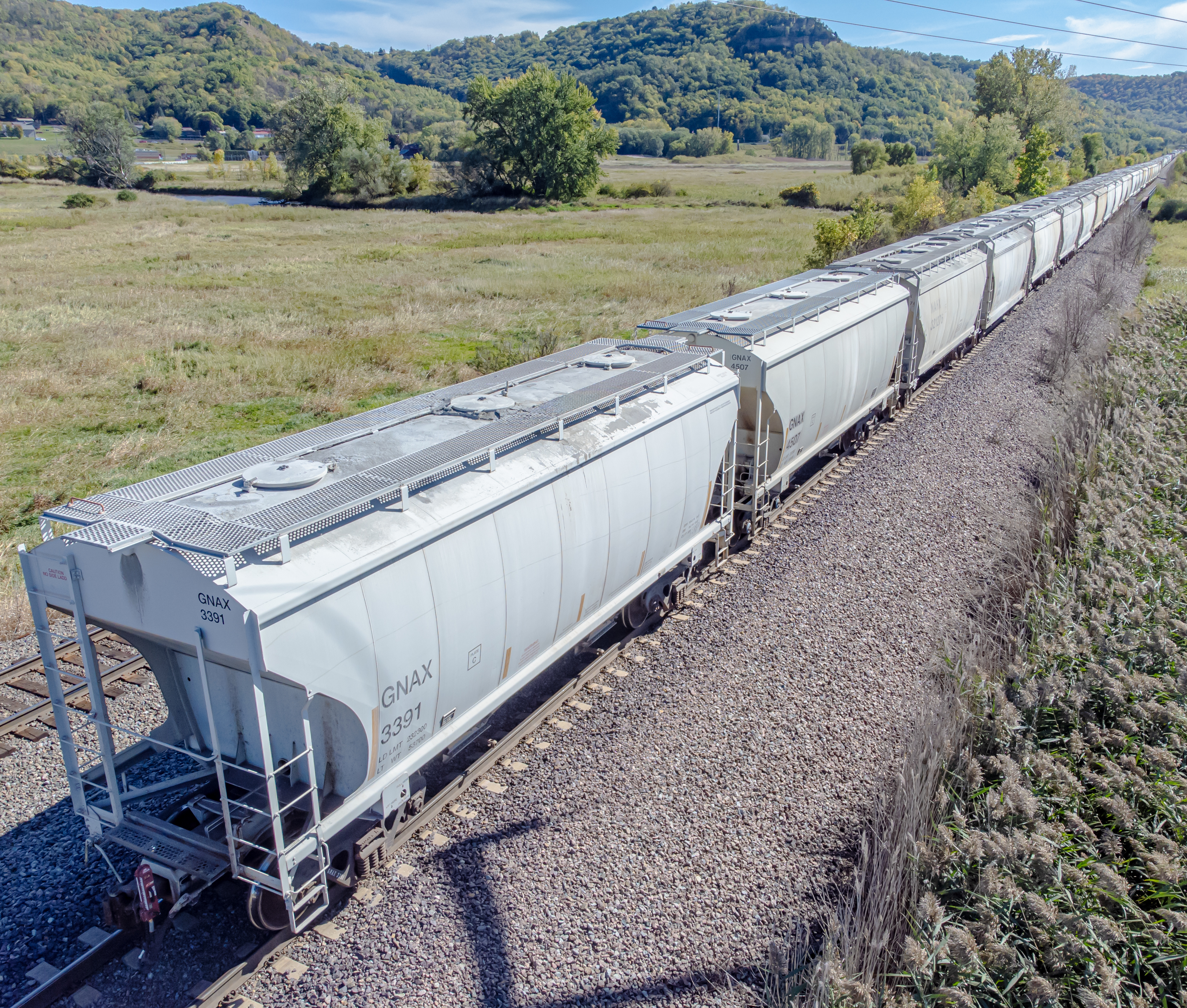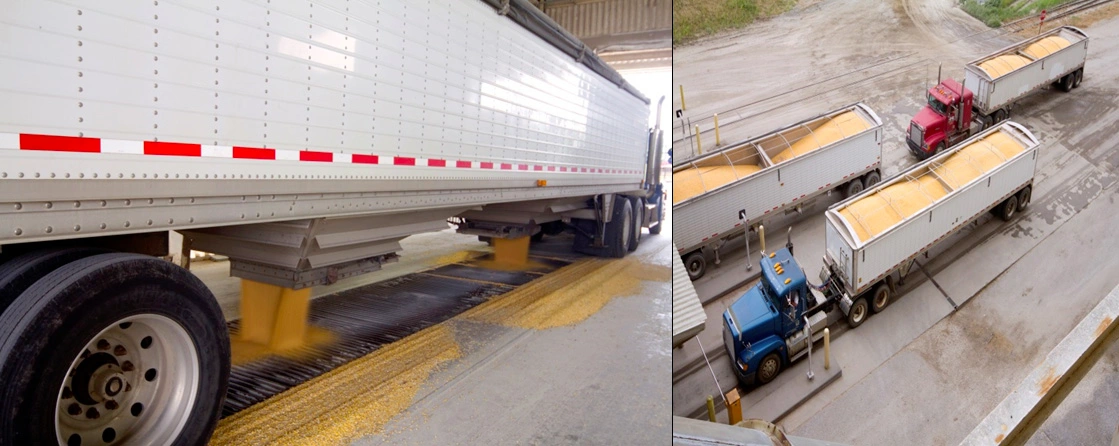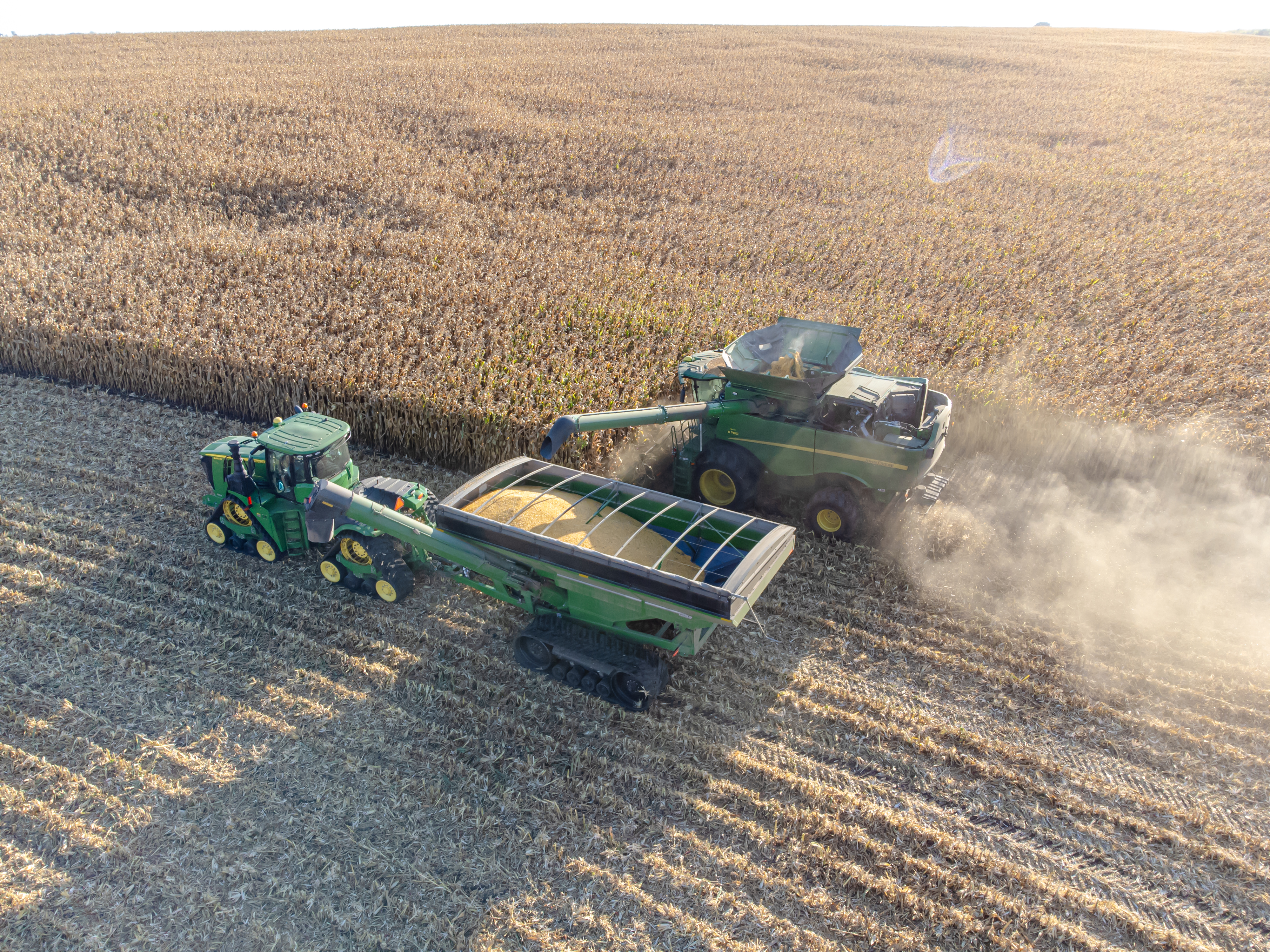|
Gravity Wagon
The gravity wagon, or slant wagon, is an angled hopper style wagon that utilizes gravity to make the unloading process easier. It is primarily used on farms for agricultural purposes, such as for holding crops or fertilizer. For easy comparison, it is similar to a railroad hopper car, only with one door which is located on the bottom side rather than on the bottom center. Description A gravity wagon has three sides which are angled at about 45 degrees and one side that is vertical. An unloading door is located at the bottom of the vertical side where the three angled sides come together. This design causes the contents of the wagon to funnel towards the door so that no effort has to be put forth to unload the contents other than opening the door, which opens upwards by the action of a lever or turning of a wheel. The chassis used for gravity wagons is sometimes the same as the chassis used for hay wagons. See also * Forage wagon * Grain hopper trailer * Combine harveste ... [...More Info...] [...Related Items...] OR: [Wikipedia] [Google] [Baidu] |
Gravity Wagon Double
In physics, gravity (), also known as gravitation or a gravitational interaction, is a fundamental interaction, a mutual attraction between all massive particles. On Earth, gravity takes a slightly different meaning: the observed force between objects and the Earth. This force is dominated by the combined gravitational interactions of particles but also includes effect of the Earth's rotation. Gravity gives weight to physical objects and is essential to understanding the mechanisms responsible for surface water waves and lunar tides. Gravity also has many important biological functions, helping to guide the growth of plants through the process of gravitropism and influencing the circulation of fluids in multicellular organisms. The gravitational attraction between primordial hydrogen and clumps of dark matter in the early universe caused the hydrogen gas to coalesce, eventually condensing and fusing to form stars. At larger scales this results in galaxies and clusters, ... [...More Info...] [...Related Items...] OR: [Wikipedia] [Google] [Baidu] |
Gravity
In physics, gravity (), also known as gravitation or a gravitational interaction, is a fundamental interaction, a mutual attraction between all massive particles. On Earth, gravity takes a slightly different meaning: the observed force between objects and the Earth. This force is dominated by the combined gravitational interactions of particles but also includes effect of the Earth's rotation. Gravity gives weight to physical objects and is essential to understanding the mechanisms responsible for surface water waves and lunar tides. Gravity also has many important biological functions, helping to guide the growth of plants through the process of gravitropism and influencing the circulation of fluids in multicellular organisms. The gravitational attraction between primordial hydrogen and clumps of dark matter in the early universe caused the hydrogen gas to coalesce, eventually condensing and fusing to form stars. At larger scales this results in galaxies and clust ... [...More Info...] [...Related Items...] OR: [Wikipedia] [Google] [Baidu] |
Farms
A farm (also called an agricultural holding) is an area of land that is devoted primarily to agricultural processes with the primary objective of producing food and other crops; it is the basic facility in food production. The name is used for specialized units such as arable farms, vegetable farms, fruit farms, dairy, pig and poultry farms, and land used for the production of natural fiber, biofuel, and other biobased products. It includes ranches, feedlots, orchards, plantations and estates, smallholdings, and hobby farms, and includes the farmhouse and agricultural buildings as well as the land. In modern times, the term has been extended to include such industrial operations as wind farms and fish farms, both of which can operate on land or at sea. There are about 570 million farms in the world, most of which are small and family-operated. Small farms with a land area of fewer than 2 hectares operate on about 12% of the world's agricultural land, and family farms comp ... [...More Info...] [...Related Items...] OR: [Wikipedia] [Google] [Baidu] |
Crops
A crop is a plant that can be grown and harvested extensively for profit or subsistence. In other words, a crop is a plant or plant product that is grown for a specific purpose such as food, fibre, or fuel. When plants of the same species are cultivated in rows or other systematic arrangements, it is called crop field or crop cultivation. Most crops are harvested as food for humans or fodder for livestock. Important non-food crops include horticulture, floriculture, and industrial crops. Horticulture crops include plants used for other crops (e.g. fruit trees). Floriculture crops include bedding plants, houseplants, flowering garden and pot plants, cut cultivated greens, and cut flowers. Industrial crops are produced for clothing (fiber crops e.g. cotton), biofuel (energy crops, algae fuel), or medicine (medicinal plants). Production There was an increase in global production of primary crops by 56% between 2000 and 2022 to 9.6 billion tonnes, which represents a 0.7 ... [...More Info...] [...Related Items...] OR: [Wikipedia] [Google] [Baidu] |
Fertilizer
A fertilizer or fertiliser is any material of natural or synthetic origin that is applied to soil or to plant tissues to supply plant nutrients. Fertilizers may be distinct from liming materials or other non-nutrient soil amendments. Many sources of fertilizer exist, both natural and industrially produced. For most modern agricultural practices, fertilization focuses on three main macro nutrients: nitrogen (N), phosphorus (P), and potassium (K) with occasional addition of supplements like rock flour for micronutrients. Farmers apply these fertilizers in a variety of ways: through dry or pelletized or liquid application processes, using large agricultural equipment, or hand-tool methods. Historically, fertilization came from natural or organic sources: compost, animal manure, human manure, harvested minerals, crop rotations, and byproducts of human-nature industries (e.g. fish processing waste, or bloodmeal from animal slaughter). However, starting in the 19th cen ... [...More Info...] [...Related Items...] OR: [Wikipedia] [Google] [Baidu] |
Hopper Car
A hopper car () or hopper wagon () is a type of railroad freight car that has opening doors or gates on the underside or on the sides to discharge its cargo. They are used to transport loose solid bulk commodities such as coal, ore, grain, and track ballast. Plastic pellets and some finely ground material, similar to flour, are transported in hopper cars that have pneumatic unloading. The bottom gates on the pneumatic hoppers connect to a hose attached to industrial facilities' storage tanks. Air is injected to fluidize the railcar contents for unloading. The hopper car was developed in parallel with the development of automated handling of such commodities, including automated loading and unloading facilities. Hopper cars are distinguished from gondola cars, which do not have opening doors on their underside or sides. Gondola cars are simpler and more compact because sloping ends are not required, but a rotary car dumper is required to unload them. Some "dual-purpose" ... [...More Info...] [...Related Items...] OR: [Wikipedia] [Google] [Baidu] |
Degree (angle)
A degree (in full, a degree of arc, arc degree, or arcdegree), usually denoted by ° (the degree symbol), is a measurement of a plane (mathematics), plane angle in which one Turn (geometry), full rotation is 360 degrees. It is not an SI unit—the SI unit of angular measure is the radian—but it is mentioned in the SI Brochure, SI brochure as an Non-SI units mentioned in the SI, accepted unit. Because a full rotation equals 2 radians, one degree is equivalent to radians. History The original motivation for choosing the degree as a unit of rotations and angles is unknown. One theory states that it is related to the fact that 360 is approximately the number of days in a year. Ancient astronomers noticed that the sun, which follows through the ecliptic path over the course of the year, seems to advance in its path by approximately one degree each day. Some ancient calendars, such as the Iranian calendar, Persian calendar and the Babylonian calendar, used 360 days for a year. ... [...More Info...] [...Related Items...] OR: [Wikipedia] [Google] [Baidu] |
Funnel
A funnel is a tube or pipe that is wide at the top and narrow at the bottom, used for guiding liquid or powder into a small opening. Funnels are usually made of stainless steel, aluminium, glass, or plastic. The material used in its construction should be sturdy enough to withstand the weight of the substance being transferred, and it should not react with the substance. For this reason, stainless steel or glass are useful in transferring diesel fuel, while plastic funnels are useful in the kitchen. Sometimes disposable paper funnels are used in cases where it would be difficult to adequately clean the funnel afterwards (for example, in adding motor oil into a car). Dropper funnels, also called dropping funnels or tap funnels, have a Tap (valve), tap to allow the controlled release of a liquid. A flat funnel, made of polypropylene, utilises living hinges and flexible walls to fold flat. The term "funnel" may refer to the Chimney (locomotive), chimney or smokestack on a steam lo ... [...More Info...] [...Related Items...] OR: [Wikipedia] [Google] [Baidu] |
Chassis
A chassis (, ; plural ''chassis'' from French châssis ) is the load-bearing framework of a manufactured object, which structurally supports the object in its construction and function. An example of a chassis is a vehicle frame, the underpart of a motor vehicle, on which the body is mounted; if the running gear such as wheels and transmission, and sometimes even the driver's seat, are included, then the assembly is described as a rolling chassis. Examples Vehicles In the case of vehicles, the term ''rolling chassis'' means the frame plus the "running gear" like engine, transmission, drive shaft, differential, and suspension. The "rolling chassis" description originated from assembly production when an integrated chassis "rolled on its own tires" just before truck bodies were bolted to the frames near the end of the line. An underbody (sometimes referred to as " coachwork"), which is usually not necessary for the integrity of the structure, is built on the chassis to c ... [...More Info...] [...Related Items...] OR: [Wikipedia] [Google] [Baidu] |
Wagon
A wagon (or waggon) is a heavy four-wheeled vehicle pulled by Working animal#Draft animals, draft animals or on occasion by humans, used for transporting goods, commodities, agricultural materials, supplies and sometimes people. Wagons are immediately distinguished from carts (which have two wheels) and from lighter four-wheeled vehicles primarily for carrying people, such as carriages. Common animals which pull wagons are horses, mules, and oxen. One animal or several, often in pairs or teams may pull wagons. However, there are examples of human-propelled wagons, such as Corf (mining), mining corfs. A wagon was formerly called a wain and one who builds or repairs wagons is a Wainwright (occupation), wainwright. More specifically, a wain is a type of horse- or oxen-drawn, load-carrying vehicle, used for agricultural purposes rather than transporting people. A wagon or cart, usually four-wheeled; for example, a haywain, normally has four wheels, but the term has now acquired s ... [...More Info...] [...Related Items...] OR: [Wikipedia] [Google] [Baidu] |
Grain Hopper Trailer
A grain hopper trailer is a trailer pulled by a semi tractor and used to haul bulk commodity products, such as grain. These trailers are used extensively throughout the United States to transport agricultural products as well as any other commodity that can be hauled in bulk and loaded and unloaded through the trailer. Design Grain hopper or hopper-bottom trailers typically feature a rolling tarp on the top of the trailer, to enable easy loading of the product to be transported, and also offer protection during transport. They utilize two hoppers on the base of the trailer to unload to product, one servicing the rear half of the trailer, the other the front half. The output of these hoppers is usually controlled by a sliding plate on the base of the hopper, controlled by a user-operated crank handle. Usage A grain hopper trailer is used in conjunction with various other pieces of agricultural machinery to complete the harvest of a field. Combine harvesters or similar unload ... [...More Info...] [...Related Items...] OR: [Wikipedia] [Google] [Baidu] |
Combine Harvester
The modern combine harvester, also called a combine, is a machine designed to harvest a variety of cultivated seeds. Combine harvesters are one of the most economically important labour-saving inventions, significantly reducing the fraction of the population engaged in agriculture. Among the crops harvested with a combine are wheat, rice, oats, rye, barley, Maize, corn (maize), sorghum, millet, soybeans, flax (linseed), sunflowers and rapeseed (canola). The separated straw (consisting of stems and any remaining leaves with limited nutrients left in it) is then either chopped onto the field and ploughed back in, or laid out in rows, ready to be Baler, baled and used for bedding and cattle feed. The name of the machine is derived from the fact that the harvester combined multiple separate harvesting operations – Reaper, reaping, threshing or winnowing and gathering – into a single process around the start of the 20th century. A combine harvester still performs its functions ac ... [...More Info...] [...Related Items...] OR: [Wikipedia] [Google] [Baidu] |








